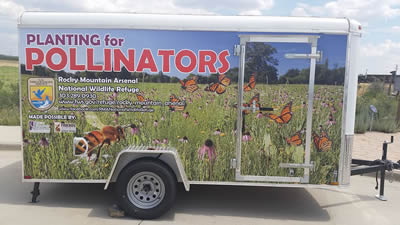Accomplishments
 The FFRWR is part of a national movement to support National Wildlife Refuges across the USA. These “Friends” groups raise much-needed funds for education programs, habitat restoration, community partnerships, and special outreach events. Here is the CORFA-Annual-Report-2023 on the many successes of the Friends groups across the country for the Coalition of Refuge Friends and Advocates (CORFA).
The FFRWR is part of a national movement to support National Wildlife Refuges across the USA. These “Friends” groups raise much-needed funds for education programs, habitat restoration, community partnerships, and special outreach events. Here is the CORFA-Annual-Report-2023 on the many successes of the Friends groups across the country for the Coalition of Refuge Friends and Advocates (CORFA).
Thanks to Friends in 2024!
- Raised
- $12,500 for Archery Shade Structure supported by CPW and AAD (cont. below)
- $2,500 from Quality Community Foundation (QCF) Commerce City
- Collaboration with Keaney middle school Art Club to create Artwork for Community Pride.
- Final artwork located on sheds bordering Lake Mary
- $9,993 from the National Environmental Education Foundation (NEEF)
- Supports adaptive fishing programs targeted towards veterans and community members
- Nature’s Nest store sales have increased by 34%
- 100% of store sales support the Front Range National Wildlife Refuges
- Provided $21,500 to partner organizations for volunteer efforts through grant funding
- Partner organizations providing volunteer support include Environmental Learning for Kids, Volunteers for Outdoor Colorado, and the Boys and Girls Clubs of Metro Denver
- Purchased
- Animal health supplies for Black-Footed Ferrets and annual Bison Gathering
- Seeds for the pollinator garden
- Outreach materials as a partner of Generation Wild NEMC
- Architecture plans for Historical Conservation of the Egli House, support from History Colorado
- Achieved over 1,200 hours of accrued Volunteer time thanks to Volunteer Coordinator
- FFRWR Volunteer Coordinator position is supported by federal award Increasing Inclusivity in Volunteer Programs
- Successful community events including Earth Day at RMA, tabling at community events, and many volunteer projects
- Contracted artists for 56th Street artwork at RMANWR entrances Chambers and Uvalda
- Partnered with Montbello art club students at ELK and Dr. Martin Luther King, Jr. Early College to gain community input on artwork
- Celebrated Generation Wild NEMC Youth Council involvement for 2023-2024 and outgoing Board Members
- Welcomed new Board Members
- Susan Noble and Rocky Teter, Councilmembers for Commerce City
- Michelle Suebert, Manager Cherry Creek State Park
- Jack Markovich, Senior Accountant at Denver Zoological Foundation
- Vicki Vargas-Madrid, Education & Wildlife Program Manager Denver Parks & Recreation/Denver Mountain Parks
- Hired
- General Manager to take over contracts, communications, and employment
- Nature’s Nest Coordinator to oversee store activities and volunteers
Friends Receives Shade Structure Grant for Archery Range
Friends of the Front Range Wildlife Refuges has been awarded a Shade Structure Grant from the American Academy of Dermatology. The grant will enable a permanent shade structure to be built over the Archery Range located at RMANWR that will protect children and adults each day from the sun’s harmful ultraviolet rays.
Protection from the sun is incredibly important at our refuge due to the intense UV rays and lack of trees surrounding the archery range.
Since its launch in 2000, the AAD’s Shade Structure Grant Program has awarded funding for more than 450 shade structures, which provide shade for more than 3.5 million individuals each day. Board-certified dermatologist Dr Dellavalle, a member of the AAD, and two University of Colorado Anschutz medical students, Kenzie Hanigan and Ferdos Abdulkader sponsored Friends’ grant application.
According to the AAD, skin cancer is the most common cancer in the United States, and it only takes one blistering sunburn during childhood or adolescence to nearly double a person’s chance of developing melanoma, the deadliest form of skin cancer, later in life. Seeking shade is an easy way to reduce the risk of skin cancer, along with covering up and wearing a broad-spectrum, water-resistant sunscreen with an SPF of 30 or higher.
The Shade Structure Grant Program is part of the AAD’s SPOT Skin Cancer™ campaign to reduce the incidence of skin cancer by educating the public about effective skin cancer prevention tips. To learn more about the Shade Structure Grant Program or for ways to prevent and detect skin cancer, visit SpotSkinCancer.org.
What has the nonprofit organization, Friends of the Front Range Wildlife Refuges, accomplished in 2022 and 2023?
Every year, we buy nature supplies for environmental education programs. We bring raptor programs and zoo and farm animals to the Visitor Center for special programming. We support the annual volunteer luncheon to thank the wonderful refuge volunteers and much more!
We get youth into the outdoors! The FFRWR hosts the Generation Wild Northeast Metro Coalition of three cities, seven nonprofits, and state and federal agencies that receive grants from the Colorado Lottery funded Great Outdoors Colorado. Funding brings students from the four target neighborhoods (Commerce City, Northeast Park Hill, Montbello, and Northwest Aurora) to the refuge and supports the Spanish language Wildlife Drive program and the annual GoWild In Your Park/Refuge Day community event in the fall. For more information see: https://www.generationwild.com/
For wonderful ideas about what to do with your kids outdoors, check out the Generation Wild’s list of 100 outdoor activities, your path to fun all year round — from your backyard to the backcountry. Click here for the English PDF or here for the Spanish PDF.
FFRWR plays a critical role in educating the community about the critical role the refuge plays in wildlife and habitat protection and community engagement. Recently designated as a Flagship Urban Refuge, the Rocky Mountain Arsenal follows these US FWS Standards (https://www.fws.gov/media/urban-wildlife-conservation-program-standards-excellence)
The future success of conservation lies ultimately in our ability to inspire Americans to connect with the outdoors and nature, and to become stewards of the environment. Americans are spending less time outdoors and are becoming more ethnically and racially diverse. With more than 80% of Americans now living in urban areas, our challenge is to become relevant in their daily lives. Without public awareness and support, our conservation mission will not succeed. The Urban Wildlife Conservation Refuge Program follows these eight standards of excellence that serve as a framework for collaboration among the U.S. Fish and Wildlife Service and local communities:
- Know and relate to the community.
- Use stepping stones to engage people in nature.
- Build partnerships.
- Be a community asset.
- Ensure adequate long-term resources.
- Provide equitable access.
- Ensure visitors feel welcome and safe.
- Model sustainability.





